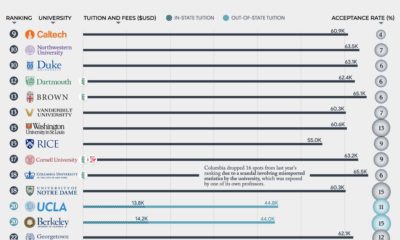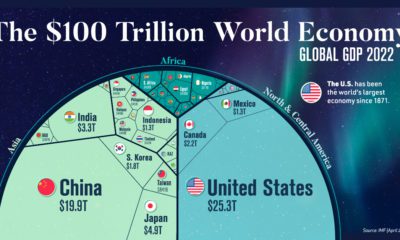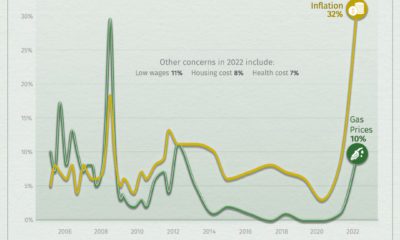It’s easy to see why. Not only does the country provide access to world-class economic hubs like Silicon Valley, but the U.S. is also home to 14 of the top 20 universities in the world, many of which are famed for their research and alumni networks. Yet, there is cause for concern. International enrollments in the U.S. have slowed, while other countries are attracting a larger share of the global talent pool. To help us understand what’s at stake if enrollments continue to decline, today’s infographic shows the impact of international students on the U.S. economy.
Driving American Innovation and Growth
International students and scholars are a vital economic asset, and America’s ability to attract them puts the country in an enviable position. First, there are the direct economic benefits which result from tuition fees and living expenses. Throughout the 2018/2019 school year, these benefits totaled $41 billion, a comparable value to many other American exports: Source: NAFSA, Evans, WorldCity Even after graduation, however, international students and scholars continue to make significant contributions to the U.S. economy. For example, attracting the world’s brightest minds helps to grow the knowledge economy in the United States, and 40% of American Nobel Prizes won in chemistry, medicine, and physics since 2000 have been awarded to immigrants. Furthermore, students who return home often do so with a network of connections and an appreciation for American culture, thus promoting U.S. international leadership. Finally, these individuals can also go on to become successful entrepreneurs and business leaders in the U.S. economy. The list is long, but here are two noteworthy examples:
Elon Musk, known for founding Paypal, Tesla, and SpaceX, was born in South Africa. He received two Bachelor’s degrees from the University of Pennsylvania before founding his first business. Satya Nadella, CEO of Microsoft, was an international student from India. He received an M.S. from the University of Wisconsin and an MBA from the University of Chicago before helping Microsoft develop its cloud computing capabilities.
Cause for Concern
In recent years, however, the number of new international students enrolling at U.S. institutions has been on the decline: Source: Institute of International Education With so many opportunities and success stories, why have international enrollments slowed? A survey of 509 higher education institutions in the U.S. revealed the top reasons for declining international enrollments: Source: NAFSA Critically, the two most common reasons for declining enrollment—visa applications and the social and political environment—suggest that the quality of an American education is not the issue. Rather, it would appear that students are being discouraged from coming to the United States. – Dr. Martha E. Pollack, President, Cornell University At the same time, other countries are taking proactive measures to attract global talent.
Australia
Australia allows its international students to work for up to 18 months after graduation. This limit can increase to 4 years for graduates of high-demand occupations. In 2018, the country saw a 15% increase in international enrollments.
Canada
Canada, a country distinguished for its multiculturalism, is quickly becoming an attractive destination for international students. The country offers expedited visa processing for qualified individuals, as well as a 3-year work visa for graduates. In 2017, international enrollments in Canada grew by an impressive 20%.
Potential Consequences
The world’s brightest minds are an important asset for continued innovation and growth, and today, there is a mass of countries welcoming them with open arms. While the U.S. is still the preferred destination for international students and scholars, the country’s leadership in this space is at risk. In fact, since 2001, the share of international students in America has fallen from 28% to 21%. Will the U.S be able to maintain global competitiveness if the number of new international students enrolling continues to fall? Can the country work to cultivate a more welcoming and barrier-free route to higher education? These are potent questions that will need to be answered, especially with a sizable economic impact on the line. on Even while political regimes across these countries have changed over time, they’ve largely followed a few different types of governance. Today, every country can ultimately be classified into just nine broad forms of government systems. This map by Truman Du uses information from Wikipedia to map the government systems that rule the world today.
Countries By Type of Government
It’s important to note that this map charts government systems according to each country’s legal framework. Many countries have constitutions stating their de jure or legally recognized system of government, but their de facto or realized form of governance may be quite different. Here is a list of the stated government system of UN member states and observers as of January 2023: Let’s take a closer look at some of these systems.
Monarchies
Brought back into the spotlight after the death of Queen Elizabeth II of England in September 2022, this form of government has a single ruler. They carry titles from king and queen to sultan or emperor, and their government systems can be further divided into three modern types: constitutional, semi-constitutional, and absolute. A constitutional monarchy sees the monarch act as head of state within the parameters of a constitution, giving them little to no real power. For example, King Charles III is the head of 15 Commonwealth nations including Canada and Australia. However, each has their own head of government. On the other hand, a semi-constitutional monarchy lets the monarch or ruling royal family retain substantial political powers, as is the case in Jordan and Morocco. However, their monarchs still rule the country according to a democratic constitution and in concert with other institutions. Finally, an absolute monarchy is most like the monarchies of old, where the ruler has full power over governance, with modern examples including Saudi Arabia and Vatican City.
Republics
Unlike monarchies, the people hold the power in a republic government system, directly electing representatives to form government. Again, there are multiple types of modern republic governments: presidential, semi-presidential, and parliamentary. The presidential republic could be considered a direct progression from monarchies. This system has a strong and independent chief executive with extensive powers when it comes to domestic affairs and foreign policy. An example of this is the United States, where the President is both the head of state and the head of government. In a semi-presidential republic, the president is the head of state and has some executive powers that are independent of the legislature. However, the prime minister (or chancellor or equivalent title) is the head of government, responsible to the legislature along with the cabinet. Russia is a classic example of this type of government. The last type of republic system is parliamentary. In this system, the president is a figurehead, while the head of government holds real power and is validated by and accountable to the parliament. This type of system can be seen in Germany, Italy, and India and is akin to constitutional monarchies. It’s also important to point out that some parliamentary republic systems operate slightly differently. For example in South Africa, the president is both the head of state and government, but is elected directly by the legislature. This leaves them (and their ministries) potentially subject to parliamentary confidence.
One-Party State
Many of the systems above involve multiple political parties vying to rule and govern their respective countries. In a one-party state, also called a single-party state or single-party system, only one political party has the right to form government. All other political parties are either outlawed or only allowed limited participation in elections. In this system, a country’s head of state and head of government can be executive or ceremonial but political power is constitutionally linked to a single political movement. China is the most well-known example of this government system, with the General Secretary of the Communist Party of China ruling as the de facto leader since 1989.
Provisional
The final form of government is a provisional government formed as an interim or transitional government. In this system, an emergency governmental body is created to manage political transitions after the collapse of a government, or when a new state is formed. Often these evolve into fully constitutionalized systems, but sometimes they hold power for longer than expected. Some examples of countries that are considered provisional include Libya, Burkina Faso, and Chad.













